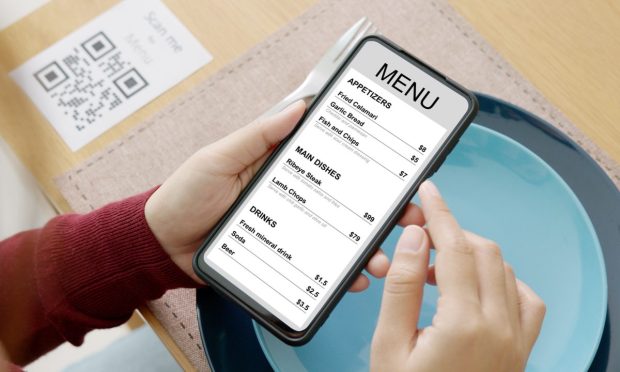SpotOn CTO: Restaurants Must Perform ‘Daily Hygiene’ on QR Codes

With the rise of QR codes has come the rise of QR code fraud.
Last month, the FBI issued a public service announcement warning that cybercriminals have been tampering with these codes to redirect victims to malicious sites that steal sensitive information. For restaurants, this means getting more careful about checking the codes they are using to power contactless menus and payment capabilities.
Read more: FBI Warns of QR Code Cybercrimes
“QR codes have become a vital resource for restaurants,” Mark Walz, chief technology officer of San Francisco, California-based payments and software company SpotOn, told PYMNTS in an interview. “We’ve seen QR codes be misappropriated around the world, and now it’s happening in the U.S., and so restaurants just have to take some precaution and perform some daily hygiene, if you will, around those QR codes.”
He added that restaurants should be checking regularly to ensure that the codes are those they have put out and that they direct to the proper sites.
Certainly, QR codes have become commonplace at restaurants of all kinds across the country, according to data from the most recent edition of PYMNTS’ Digital Divide report, “The Digital Divide Report: Technology As A Catalyst For Restaurant Purchases,” created in collaboration with Paytronix. The study, which was conducted early December and featured a census-balanced survey of more than 2,400 United States adults, revealed that 43% of consumers eat from full-service restaurants (FSRs) with QR code menus, and 32% from quick-service restaurants (QSRs) with the same.
See more: How Eateries Can Tap Order Throttling Tools as Delivery Demand Grows
One Size Does Not Fit All
Ben Pryor, SpotOn’s head of Innovation, added that as fine dining establishments have been scaling back their use of QR codes, other kinds of restaurants — those that “have a unique service style, so a bar/nightclub environment, a food hall, those kinds of multi-hyphenated businesses,” as well as fast-casual brands and QSRs — continue to “lean into” the technology.
QR codes are important to a relatively small but far from negligible share of diners. The “Technology As A Catalyst For Restaurant Purchases” study noted that 19% of consumers stated that the availability of payable QR codes would encourage them to make restaurant purchases, and 17% said the same of a QR-code-powered, end-to-end experience.
Across the industry, restaurants are increasingly seeking out technologies to fit their unique and often ever-evolving needs. Pryor noted that restaurants are looking for “a system that’s extremely light and flexible that, depending on the type of business that somebody is operating, they can turn on or off features.”
He specified that these features include ordering technologies such as QR codes, delivery modules and kiosks, as well as payment systems such as handheld point-of-sale (POS) devices.
For example, he cited a beer garden/food hall that activates its handhelds on busy nights to enable quicker turnover and noted that many restaurants have been turning on and off various off-premise options at different times of the week.
Own-Device Loyalty
Discussing the ways in which payment technologies can influence customer loyalty, Pryor noted that consumers are more likely to keep coming back if they can interact with the restaurant through their own devices, which at this point “fee[l] like an attachment of the individual consumer.”
He added, “We find that consumers generally are a lot more comfortable from a data perspective, security, etc., interacting with their own device.”
Just under one in four consumers would be encouraged to make more restaurant purchases if they could pay with their digital wallets, according to data from the Technology As A Catalyst study. The report revealed that 23% of restaurant customers would be encouraged by the feature, and 40% said they would be encouraged by the ability to pay online. Additionally, the study found that 40% of consumers visit FSRs that offer mobile device payment capabilities, and 45% visit QSRs that offer the same.
The Future of Restaurant Payments
Pryor noted that restaurants and their customers are increasingly implementing buy now, pay later (BNPL) purchasing, although he does not expect that the payment method will take hold for day-to-day restaurant purchases anytime soon.
“We’re seeing [BNPL] come into restaurants in a smaller fashion, mostly because the transaction dollar amounts are much smaller [than retail],” he said. “We do see it with … reservation deposits for big groups.”
Research from PYMNTS’ January study, “Main Street Merchant Index: Optimism Amid Inflation Edition,” a Melio collaboration that surveyed 765 business owners on Main Street U.S.A. about their present situation and future plans, revealed that while only 8% of food, entertainment and accommodation businesses currently offer BNPL, a full 25% plan to implement BNPL in the next year.
Get the report: Optimism Amid Inflation
Within five years, Walz predicted, restaurants will be using a frictionless model by which payment is seamlessly integrated into the experience, powered by near-field communication (NFC) and/or biometrics using consumers’ own devices, depending on how privacy regulation standards play out.
“So, you just walk in, and in general, the systems in that facility will know who you are and will accept payment, and you’d perhaps just tap your watch,” he said. “Almost like the Amazon Go model but reimagined for a restaurant.”
